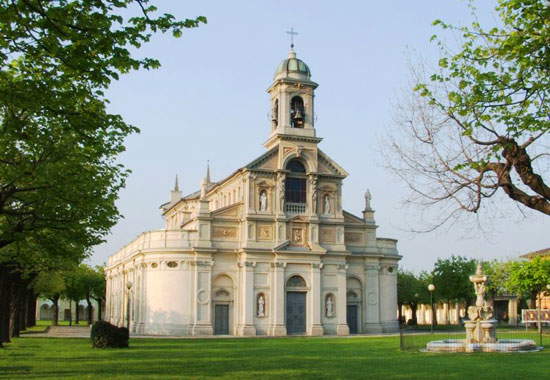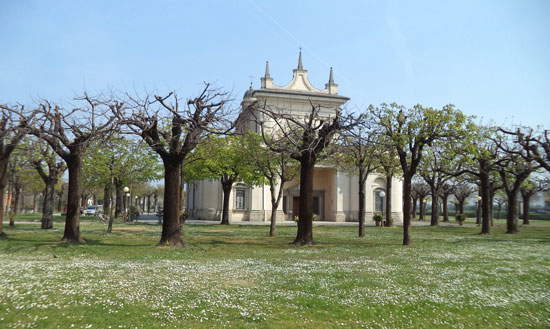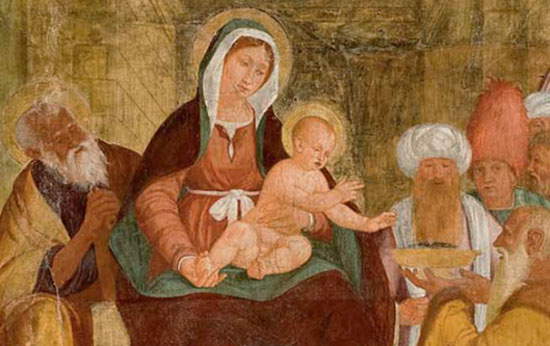At seven o’clock in the evening, we arrive at our hotel in Stezzano, after wandering around the outskirts of Bergamo for at least three quarters of an hour. The navigator has run out of steam at the best of times, and the municipal administrations of the neighboring towns have seen fit not to show directions to Stezzano, but to put up very useful signs on the state highway indicating the way to"Berghem" in dialect. Obviously underneath the sign in Italian. After repeatedly railing against whoever had the nice idea of putting signs in dialect instead of signs for Stezzano, we arrive in Dalmine and opt for the safest and oldest method: asking the natives for directions. After stopping a couple of them, within two minutes by the clock we are in Stezzano. At the hotel we recharge the navigator, and realize that with our car we have described, from Zanica to Dalmine via Orio al Serio, a fantastic semicircle in the Bergamo plain, carefully avoiding touching our destination-when you say intuition and luck.
At the hotel’s front desk, obviously omitting the fact that we managed to get lost in an area of not even five square kilometers, we ask for directions to any restaurant, as long as it has two characteristics: that it is easily accessible and that it offers good food. “Go over the overpass you see back here, and go straight for about a kilometer: on the left you will find the Stezzano shrine, on the right a parking lot. The restaurant is right after that.” We decide to follow the hotel guy’s directions and find ourselves in a fairly low-key but very cozy place, with couples arguing with each other in low voices, cheerful peasants refreshing themselves after a day’s work, and tables of friends talking in tight Bergamasque over fish dishes. Indeed, we discover that the trattoria specializes in fish, especially when the waitress proposes the dish of the day: ravioli alla ligure. Since ravioli alla ligure, since we live on the border with Liguria, are typical of our habitat and are therefore part of our almost daily diet, we opt for a steaming plate of casoncelli, which we think is more suitable for two people eager to discover the delicacies of the local cuisine. Having finished the casoncelli, bottled the pitcher of red wine, and also finished the two walnut tarts ordered to sweeten the palate, we go out and linger for a few moments in front of the sanctuary of the Madonna dei Campi: it is a building that, if placed in an urban context, would probably not even jump out at us, but like this, in the middle of the fields and surrounded by greenery, it seems perhaps more imperious and more solemn than it really is. We therefore vow to visit it again in daylight. Not least because it is not possible at night.
Two days later we return to the shrine early in the morning, that is, past ten o’clock (after all, it is the last day of our pleasure trip). We go through the gate leading into the park, walk down the driveway sprinkled with signs urging all kinds of silence, and find ourselves in front of the facade designed by architect Enrico Galbiati in the late 19th century. The façade is classical, tripartite, with the central part slightly projecting because it juts out slightly. The parts are divided by Ionic pilasters, and the main portal is surmounted by a broken tympanum. On the cornice above are some reliefs and, still higher up, a large window with balustrade surmounted by a graceful bell tower crowned with a small dome. Decorating it all are statues of saints and also two telamons holding up the arch above the window: classical and Christian elements come together with exceptional harmony. We try to enter, but what we think is the main portal actually hides a small shrine with a statue of the Madonna. Yes, because we realize that the one facing the street is not the main façade: it is a contrivance to cover the apse of the church, because the entrance is on the opposite side, that is, on the side facing the fields. However, the statue of Our Lady has a certain importance. In fact, for the faithful it is fundamental, because the shrine was built on the very spot where Our Lady is said to have appeared.
 |
| Sanctuary of Our Lady of the Fields in Stezzano: the facade facing the road. Photo by Luigi Chiesa (Creative Commons license) |
Since ancient times, Stezzano has always been a farming village. And one fine day in the 13th century, it seems that Our Lady had appeared to a peasant woman in the village: it was after this event that the first small church dedicated to Our Lady of the Fields was erected. For several centuries there were no more apparitions, and the fact that the shrine was outside the town (as it still is today) contributed, in the late sixteenth century, to it going through several decades of neglect. But in 1586, in addition to the occurrence of a new apparition, water allegedly flowed from the place where Our Lady was seen, to which the inhabitants of Stezzano attributed miraculous properties. It was therefore decided to raise the ancient little church from decay and, indeed, to radically renovate it, also to better accommodate the 14th-century tablet that was preserved there and became the object of heartfelt and passionate worship. Renovation work on the shrine ended in the mid-seventeenth century, and then resumed in the nineteenth century: to the latter we owe the shrine’s current appearance.
 |
| The main facade of the Sanctuary of the Madonna dei Campi in Stezzano... covered by trees |
We then move to the opposite side of the sanctuary and enter: the interior is full of colorful stucco, sumptuous decorations, and of course exceptionally fine works of art. The main one is certainly Andrea Previtali’sAdoration of the Magi, a fresco transported on canvas dating from 1518: it is signed and dated (ANDREAS PRIVITALVS PINXIT / MD XVIII) and, despite the fact that the spatial setting is still 15th-century, with the figures arranged in a semicircle in a central vanishing point architecture scaled in perspective, the characters show a vitality that seems to derive from the example of Lorenzo Lotto, a fundamental painter for all artists in the Bergamo area at the time. Then there are later works: frescoes by Gian Paolo Cavagna, including a beautiful Assumption of the Virgin, some angels by Carlo Ceresa, works by Antonio Cifrondi, Marco Olmo, Giuseppe Roncelli and many other artists of the local school, such that the sanctuary of the Madonna dei Campi is unique for those who want to know about the developments of painting in Bergamo from the 16th century onward.
After making this journey into local art and spirituality, we leave the church and walk under the portico in front. A simple portico, stained white, from which hang small paintings depicting the Stations of the Cross. In front, the lawn is filled with daisies, and the trees partially conceal the view of the main facade: square, with a large entrance arch with a balcony, topped by a continuous entablature supporting three spires. We reflect on the fact that the most beautiful facade is actually the non-facade, the one facing the main street, and how it is one of the rare instances when one is faced with a church with two facades. Finally, let’s look beyond the porch gate: only the sound of tractors can be heard in the fields.
 |
| Andrea Previtali, Adoration of the Magi (1518; Stezzano, Sanctuary of the Madonna dei Campi) - detail |
For those who would like more information about the shrine of Madonna dei Campi in Stezzano, we recommend its website, which moreover is full of information about the church’s history and art: www.madonnadeicampi.org
Warning: the translation into English of the original Italian article was created using automatic tools. We undertake to review all articles, but we do not guarantee the total absence of inaccuracies in the translation due to the program. You can find the original by clicking on the ITA button. If you find any mistake,please contact us.